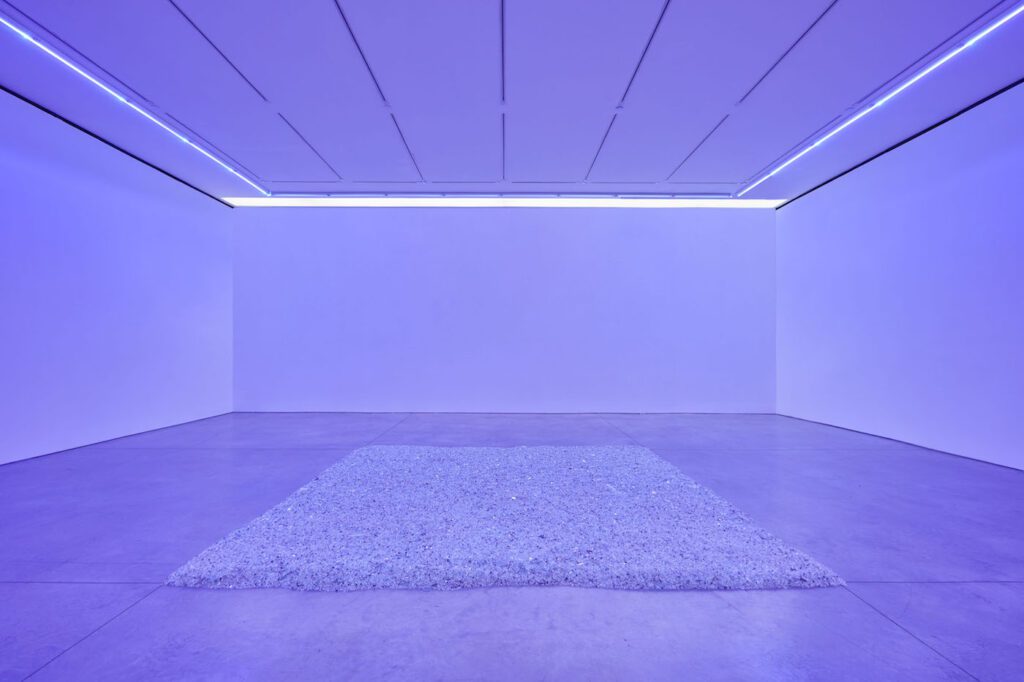Marianne Boesky Gallery, New York, United States
19 Jan 2019 - 16 Feb 2019

Paul Stephen Benjamin, Ceiling, 2017. Courtesy of the artist and Marianne Boesky Gallery, New York and Aspen. © Paul Stephen Benjamin. Photo credit: Jason Wyche.
Marianne Boesky Gallery presents Pure, Very, New, Atlanta-based artist Paul Stephen Benjamin’s first solo exhibition in New York. Presented across both of the gallery’s Chelsea locations, at 509 and 507 W. 24th Street, the exhibition will feature Benjamin’s paintings, photographs, sculpture, and single and multi-channel video installations, as well as a new site-specific black light installation to be created in the internal passageway between the two spaces.
Curated by independent curator Lisa Freiman, the exhibition will highlight Benjamin’s years-long examination of the word “black” as a linguistic, conceptual, and cultural construct. Pure, Very, New, which will be accompanied by a catalogue, will remain open through February 16, 2019.
Benjamin’s practice is rooted in a vigorous meditation on blackness, considering: “What is the color black?” “What does black sound like?” “Is it an adjective, a verb, an essence, or all of these components mixed to create a nuanced whole?” For his large-scale monochromatic paintings, Benjamin thickly coats the canvas in varying shades of black, producing a sensation of boundless depth. This is further accentuated by Benjamin’s application of the particular tonality’s name within the field of color—the words appearing to float and dissipate within the richness of the paint itself. The development of these paintings followed an ordinary visit to a hardware store, where Benjamin was confronted with the many permutations of commercial black paint. Shades of black came with emotive titles like “Totally Black,” “New Black,” and “Pure Black,” among numerous others. For Benjamin, this sparked a multi-layered investigation of the color and whether it could be distilled or understood differently within the context of a painting or the color itself.
Benjamin’s use of the monochrome and the formal language of seriality, repetition, and wholeness extend the strategies first introduced by Minimalist artists like Frank Stella, Dan Flavin, and Sol LeWitt. Indeed, Benjamin is particularly concerned with the seemingly endless aesthetic experiences that his continued deconstruction of form and color can yield. At the same time, his insertion of language within the Minimalist tradition evokes a broader questioning of the relationships between words and meaning, and the ways in which a particular context can evoke a range of associations. What does and can “Pure Black” mean, and is that altered by its presentation on a pure black canvas or alongside another type of black?
These kinds of implications take on further meaning in works like Paint the White House Totally Black (2017), in which Benjamin has replaced specific color titles with images. While Benjamin does not ascribe a particular political or social perspective to the work, he provides a platform through which to consider the complexities of language, cultural and racial constructs, and the malleability of reality as it is shaped by our own experiences and subjectivities. For Benjamin, the open-ended and interpretative quality of his works is an important completing facet.
Benjamin’s practice also extends into a conceptual investigation of sound, and how “black” can be conveyed and experienced aurally. In these works, he often uses single and multi-channel video installations to loop portions of particular historic and cultural footage to isolate fragments of collective memories or internalized narratives. With Black is the Color (2014), which will be included in the exhibition, Benjamin arranges a towering cluster of antiquated televisions, forming a glowing grid that endlessly repeats a segment of Nina Simone’s 1959 performance of “Black is the Color of My True Love’s Hair.” Here, Benjamin appropriates only the words “Black is the Color,” creating an abstraction of the song that reveals the contradictions and parallels between the notion of black being the color and it being a color. Moving fluidly from sound installation to painting to photography and sculpture, Benjamin’s practice is driven by the idea that blackness, whether explored as a matter of conceptual inquiry or identity, cannot be captured in a single action, emotion, or language.
Paul Stephen Benjamin received his BA from the University of Illinois at Urbana-Champaign and his MFA from Georgia State University. In 2018, he exhibited Black is the Color at the Tacoma Art Museum, Tacoma, WA. He’s been included in solo and group exhibitions at a variety of institutions and art spaces, including Tacoma Art Museum, Tacoma, WA (2018), Telfair Museum Jepson Center, Savannah, GA (2018), The Studio Museum in Harlem, Harlem, NY (2017), Museum of Contemporary Art of Georgia, Atlanta, GA (2017), Hyde Park Art Center, Chicago, IL (2017), Poem 88, Atlanta, GA (2017), The Department of Cultural Affairs: City of Atlanta Gallery, Atlanta, GA (2016), Whitespace Gallery, Atlanta, GA (2015), and the Atlanta Contemporary Art Center, Atlanta, GA (2014), among others. He has received a range of awards and fellowships, including The Southern Art Prize 2018, The State Fellow of Georgia 2018, Museum of Contemporary Art of Georgia Fellow 2017, Artadia Award 2014, Winnie B. Chandler Fellowship, Hambidge Fellowship, and the Forward Arts Emerging Artists Award. Benjamin is a finalist for the distinguished Hudgins Prize in Georgia (2019). He was born in Chicago, and lives and works in Atlanta.
Dr. Lisa D. Freiman is an internationally recognized curator and art historian with over thirty years working in the modern and contemporary art field with leadership positions in museums as director, senior curator, departmental chair, as well as experience working as an art advisor and professor. She currently is an independent curator, arts consultant, and author, with a tenured faculty appointment in Virginia Commonwealth University’s #1-ranked School of the Arts.